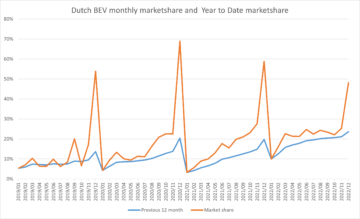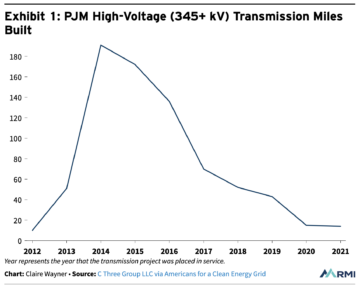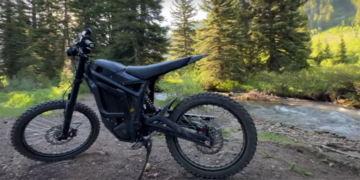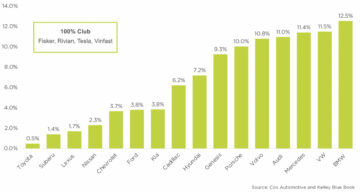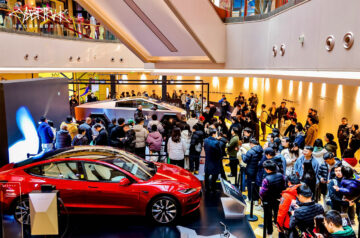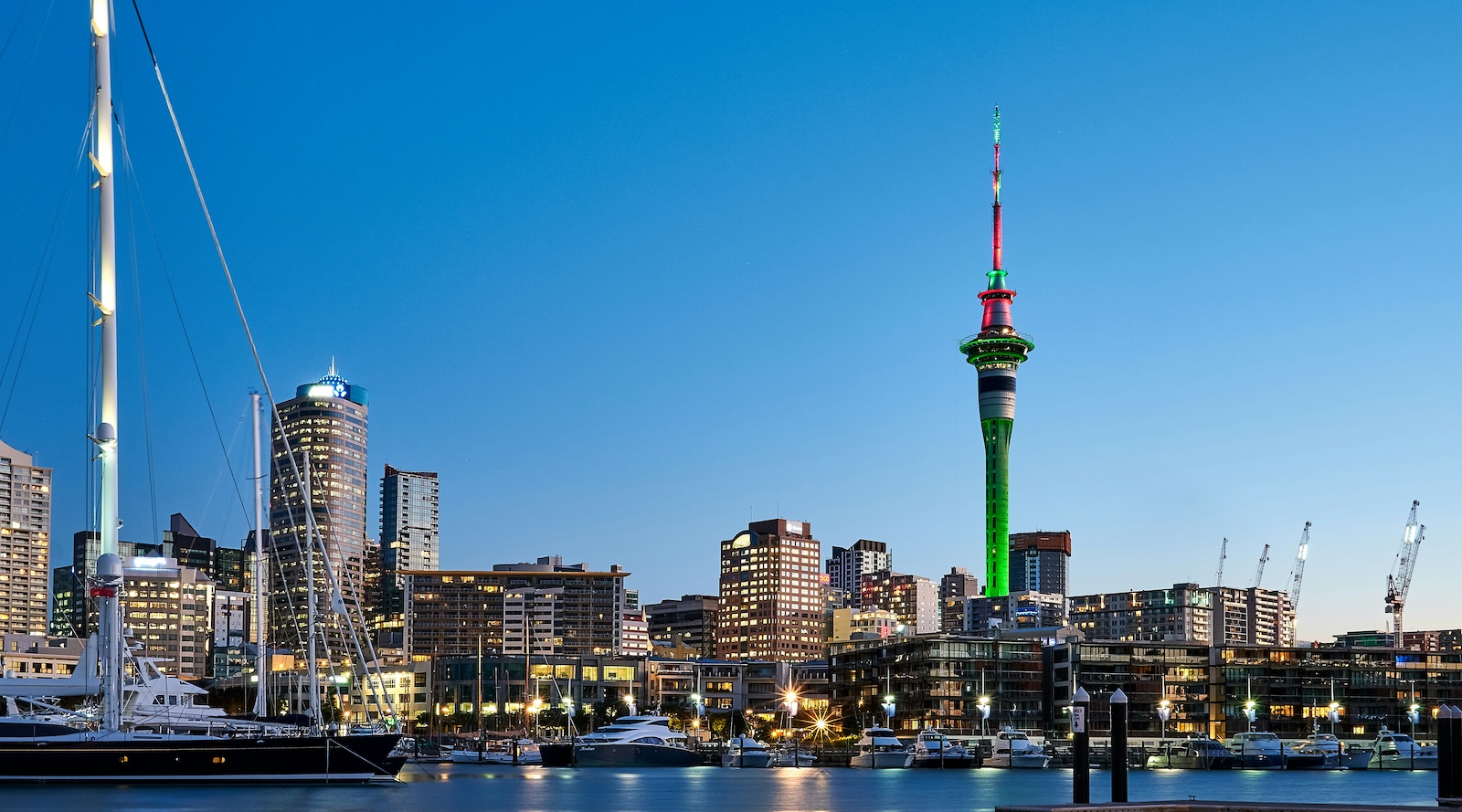
Sign up for daily news updates from CleanTechnica on email. Or follow us on Google News!
January delivered an EV market crash in plug-in electric vehicle sales in New Zealand, to their lowest level in several years. After the monster sales records of December 2023, the removal of the EV tax incentive, and the double whammy of the Road User Charge (RUC), it was to be expected. However, the size of the fall was still a shock. Sales of luxury EVs don’t appear to be affected (they didn’t receive any incentives under the previous government), and Toyota seems to have entered the BEV market — for the first time making the top ten. Quelle surprise! BMW was the top selling brand!
Stalking on the NZ EV Facebook page reveals a sanguine approach from the New Zealand electric vehicle community — “wait for a few months,” “check the quarterly data,” and “don’t forget that this year’s boats full of BYDs and Tesla’s haven’t arrived yet.” February and March data will be an interesting read — stay tuned. My “research” also revealed that there are still many chargers being installed throughout the islands of the long white cloud. So, obviously, EV uptake is expected to continue, though possibly at a slower pace. The average of the last three months is 30%, according to James at EVDB.
Only 244 new battery electric vehicles were registered in New Zealand in January 2024 (after 4,455 were registered in December 2023). The low-cost models seemed to have the highest reduction. The leader of the pack in January (supplanting the MG4) was the Seal, with 31 units, followed by the Tesla Model Y (25 units) and then third place going to the Toyota BZ4X (23 units).
Of the over 8,000 light vehicles sold in January, BEVs comprised around 3%, PHEVs took 2.5% of the market, and 2,434 plug-less hybrids were sold for 30% market share (remaining pretty much stable from December). Meanwhile, 4,340 petrol-powered cars were sold (almost 4 times what were sold in December 2023) for a 54% share of the market, and double the number of diesels were sold than in December. Ford scored well with the Everest (304 sales) and the Transit (20 sales).
The top ten best selling battery electric vehicles sold in New Zealand in January 2024 were:
- BYD Seal (31 sales, down from 159 last month)
- Tesla Model Y (25 sales, down from 356 last month)
- Toyota BZ4X (23 sales)
- Subaru Solterra (21 sales)
- Audi e-tron (14 sales)
- BMW 1 (13 sales)
- BMW 4 (12 sales)
- MG4 (12 sales, down from 622 last month)
- BMW X 1 (9 sales)
- Ford Mustang Mach-E (9 sales)
Special commendation to the Kia EV9, which had 8 sales and just missed the top 10. Of course, if we included second-hand imports, the Nissan LEAF would be top of the table with 34 units sold.
Obviously, removing the “ute tax” has hit the lower cost cars the most – three BMWs and an Audi have taken slots from so called affordable models on the charts this month. The Koreans are also having a slow month. Who would have thought we would see a Toyota model in the top ten for BEVs (or Subaru)? Although, I have noticed the BZ4X selling well in Europe and getting in the top 20 in some countries. I wish Toyota well and hope they soon join the EV party with full enthusiasm. It would be great if they could transition their dealerships and customers from HEV to BEV. Time will tell.
As was to be expected, there was a great deal of commentary on the NZ EV Facebook page about Toyota’s inclusion. Some found it beyond belief. Others thought that it was mainly driven by brand loyalty and Toyota’s reputation for reliability. My concern would be about how long brand loyalty will last if Toyota can’t compete with other brands — for value — mainly BYD and Tesla. Hopefully, cross shopping will occur. I am sure there will be lots of conversations around the chargers. Will Toyota join the other brands in accessing Tesla’s super charging network? Will we continue to react like Pavlov’s dogs?
Some commentators point to Toyota’s very successful marketing campaigns, loyal fan base, and fleet buyers. Will Toyota stop preferencing HEVs over BEVs? When will it be able to let go of hydrogen? Some point out that Toyota’s (and Subaru’s) e-TNGA platform is quite new and needs to be road proven. So much so that one inquisitive EV shopper took the BZ4X for a drive and concluded that it felt like driving a first-generation EV, boring and missing a lot of features that you would expect from a modern electric vehicle.
For a longer review see here:
[embedded content]
Perhaps the best comment was: time to stop sneering at Toyota. Yes, they are late. While what they are offering is not as good as a Tesla or as cheap as a BYD, people trust the Toyota brand. The more EVs on the road, the better. Hear, hear I say.
The top ten selling plug-in hybrids in January 2024 (PHEVs) were:
- Porsche Cayenne (24 sales)
- Mitsubishi Eclipse Cross (18, down from 249 last month)
- Volkswagen Tuareg (14)
- Mini Countryman (14), down from 16 last month
- Land Rover Defender (13)
- Mitsubishi Outlander (10) down from 320 last month
- BMW X 5 (9)
- Land Rover, Rover Sport (8)
- Lexus NX (8)
- Audi Q5 (7)
All together, 202 PHEVs sold in January 2024. Putting this chart together was a weird experience due to the prevalence of luxury vehicles. I couldn’t escape the question: Will PHEVs survive without the “ute tax”? Only if there are no comparable BEV versions coming south to NZ, I expect.
The Road User Charge (RUC) will kick in on April 1st and add a cost of approximately $76 per 1000 km for the EV driver. Sounds like a lot, until you look at the cost of petrol at $3 a litre. Money leaves your wallet and goes to Saudi at an astonishing rate – it’s magic! James at EVDB tells us that under the RUC, “ big, inefficient combustion vehicles will pay the most. Although RUCs on EVs can be seen as a disincentive to go full EV, there is some incentive in the system to choose an efficient vehicle over a big gas guzzler.”
“What is the heaviest EV in NZ? Mercedes-Benz EQS 450 SUV — a 7-seater with a 108 kWh battery, and an elephantine kerb weight of 2,918 kg (at least according to the brochure). In 2024, the median price of a new EV in NZ is $79,990. Things are moving in the right direction. The entry-level price in NZ has dropped significantly (to around $50,000).”
Possibly the most bizarre reaction to the RUC is people who have bought a PHEV because of the tax incentives who are now trying to remove the electrical input so as to not have to pay up. Why did they buy a PHEV in the first place? If they used it as a PHEV, they would save plenty enough to cover the RUC.
The New Year will see more models coming to New Zealand, and as the dust settles, we may soon go back to the 30% penetration achieved throughout most of 2023. In 2024, expect to see the Zeekr, the Nissan Ariya, the Porsche Macan, the BYD Sea Lion, and the Polestar 4 enter the market. Despite the recent blip, the future looks bright, and electric.
Photo by Partha Narasimhan on Unsplash
Have a tip for CleanTechnica? Want to advertise? Want to suggest a guest for our CleanTech Talk podcast? Contact us here.
Latest CleanTechnica TV Video
[embedded content]
I don’t like paywalls. You don’t like paywalls. Who likes paywalls? Here at CleanTechnica, we implemented a limited paywall for a while, but it always felt wrong — and it was always tough to decide what we should put behind there. In theory, your most exclusive and best content goes behind a paywall. But then fewer people read it!! So, we’ve decided to completely nix paywalls here at CleanTechnica. But…
Thank you!
Advertisement
CleanTechnica uses affiliate links. See our policy here.
- SEO Powered Content & PR Distribution. Get Amplified Today.
- PlatoData.Network Vertical Generative Ai. Empower Yourself. Access Here.
- PlatoAiStream. Web3 Intelligence. Knowledge Amplified. Access Here.
- PlatoESG. Carbon, CleanTech, Energy, Environment, Solar, Waste Management. Access Here.
- PlatoHealth. Biotech and Clinical Trials Intelligence. Access Here.
- Source: https://cleantechnica.com/2024/02/07/new-zealand-ev-market-crash-5-penetration-in-january-2024/
- :has
- :is
- :not
- $3
- $UP
- 000
- 1
- 10
- 12
- 13
- 14
- 15%
- 16
- 1st
- 2%
- 20
- 202
- 2023
- 2024
- 21
- 23
- 24
- 25
- 31
- 320
- 34
- 36
- 4
- 5
- 7
- 8
- 800
- 9
- 990
- a
- Able
- About
- accessing
- According
- achieved
- add
- Advertise
- affected
- Affiliate
- affordable
- After
- almost
- also
- Although
- always
- am
- an
- and
- any
- appear
- approach
- approximately
- April
- ARE
- around
- arrived
- AS
- At
- audi
- average
- back
- base
- battery
- Battery Electric Vehicles
- BE
- because
- behind
- being
- belief
- BEST
- Better
- Beyond
- Big
- Bit
- BMW
- Boring
- bought
- brand
- brand loyalty
- brands
- Bright
- but
- buy
- buyers
- by
- byd
- called
- Campaigns
- CAN
- cars
- catl
- challenge
- charge
- charging
- Chart
- Charts
- cheap
- chip
- Choose
- cleantech
- Cleantech Talk
- Cloud
- CO
- coming
- comment
- Commentary
- commentators
- community
- Companies
- comparable
- compete
- completely
- Comprised
- Concern
- concluded
- content
- continue
- conversations
- Cost
- could
- countries
- course
- cover
- Crash
- Cross
- Customers
- data
- deal
- December
- decide
- decided
- defender
- delivered
- Despite
- DID
- direction
- Dogs
- don
- Dont
- double
- down
- drive
- driven
- driver
- driving
- dropped
- due
- Dust
- efficient
- Electric
- electric vehicle
- electric vehicles
- embedded
- enough
- Enter
- entered
- enthusiasm
- entry-level
- escape
- Europe
- EV
- everest
- evs
- Exclusive
- expect
- expected
- experience
- Fall
- fan
- Features
- February
- felt
- few
- fewer
- First
- first time
- FLEET
- followed
- For
- Ford
- found
- from
- full
- future
- GAS
- getting
- Go
- Goes
- going
- good
- Government
- great
- Guest
- had
- Have
- having
- hear
- help
- here
- highest
- Hit
- hope
- Hopefully
- How
- However
- HTTPS
- hydrogen
- i
- if
- implemented
- imports
- in
- Incentive
- Incentives
- included
- inclusion
- inefficient
- installed
- interesting
- Islands
- IT
- james
- January
- join
- just
- Kia
- kick
- Last
- Late
- leader
- least
- leaves
- let
- Level
- light
- like
- likes
- Limited
- links
- Lion
- Long
- longer
- Look
- LOOKS
- Lot
- lots
- Low
- low-cost
- lower
- lowest
- lowest level
- loyal
- Loyalty
- Luxury
- mainly
- Making
- many
- March
- Market
- market crash
- market share
- Marketing
- Marketing Campaigns
- May..
- Meanwhile
- Media
- missed
- missing
- model
- models
- Modern
- money
- Month
- months
- more
- most
- moving
- much
- my
- Need
- needs
- network
- New
- new year
- New Zealand
- news
- Nissan
- no
- noticed
- now
- number
- occur
- of
- offering
- on
- ONE
- only
- or
- Other
- Others
- our
- out
- over
- Pace
- Pack
- page
- party
- Pay
- penetration
- People
- per
- Place
- platform
- plato
- Plato Data Intelligence
- PlatoData
- player
- Plenty
- podcast
- Point
- policy
- Porsche
- possibly
- pretty
- prevalence
- previous
- price
- proven
- publish
- put
- Putting
- question
- quite
- Rate
- React
- reaction
- Read
- Reader
- receive
- recent
- record
- records
- reduction
- registered
- reliability
- remaining
- removal
- remove
- removing
- reputation
- Revealed
- Reveals
- review
- right
- road
- rover
- sales
- Saudi
- Save
- say
- SEA
- see
- seemed
- seems
- seen
- Selling
- Sets
- settles
- several
- Share
- shopper
- Shopping
- should
- significantly
- Size
- slots
- slow
- So
- sold
- some
- Soon
- sounds
- South
- Sport
- stable
- stay
- Still
- Stop
- Stories
- successful
- suggest
- Super
- support
- sure
- survive
- system
- T
- table
- taken
- Talk
- tax
- team
- tell
- tells
- ten
- Tesla
- than
- that
- The
- The Future
- their
- then
- theory
- There.
- they
- things
- Third
- this
- though?
- thought
- three
- throughout
- time
- times
- tip
- to
- together
- took
- top
- Top 10
- Top Ten
- tough
- toyota
- transit
- transition
- trip
- Trust
- trying
- tuned
- tv
- under
- units
- until
- Updates
- uptake
- us
- used
- User
- uses
- value
- Ve
- vehicle
- Vehicles
- versions
- very
- Video
- Wallet
- want
- was
- we
- weight
- WELL
- were
- What
- when
- which
- while
- white
- WHO
- why
- will
- wish
- with
- without
- would
- write
- Wrong
- X
- year
- years
- yes
- yet
- you
- Your
- youtube
- Zealand
- zephyrnet

